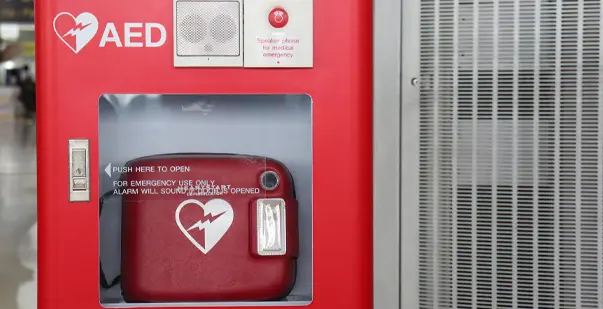When it comes to ensuring the safety of church goers and members of the church, having the right Automated External Defibrillator(AED) can make all the difference. Churches are often bustling with gatherings and other activities. It is important to keep proper emergency response systems in place, and one such tool is AED for churches.
Almost 15-20% of cardiac arrests occur out of the hospital. Choosing and implementing the right AED (automated external defibrillator) for churches can foster a safer and prepared environment. For churches, AEDs should be chosen based on their ease of use, reliability and maintenance. In this blog, we will discuss the best AEDs for churches and recommendations to help you select the most effective device.
Master ACLS Now
Get ACLS certified with confidence
Why are AEDS crucial for churches?
In any community setting, including churches, the well-being of attendees is a top priority. Churches host large gatherings and events, and need to be prepared for unexpected emergencies. Having an Automated External Defibrillator (AED) on-site can be a lifesaver. Here’s why AEDs are crucial for churches:
- Immediate Response: Sudden cardiac arrest can happen without warning. An AED provides immediate assistance by delivering a life-saving shock to restore a normal heart rhythm, increasing the chances of survival until professional help arrives.
- Peace of Mind: Knowing that your church is equipped with an AED and that staff are trained to use it offers reassurance to attendees. It shows a commitment to their safety and well-being.
- Enhanced Safety: Churches often host large events, services, and community activities. An AED ensures that there’s a prompt response to emergencies. This minimizes the risk of delays in life-saving treatment.
- Ease of Use: Modern AEDs are designed to be user-friendly, with clear instructions and automatic features. This means that even those without medical training can use the device effectively.
- Compliance with Safety: While not always legally required, having an AED aligns with best practices for emergency preparedness. It shows a proactive approach to safety and can help meet community expectations for responsible facility management.
What is the best AED for churches?
Choosing the right AED for your church ensures that you’re prepared for emergencies. With various models available, selecting the best AED involves considering features that suit your specific needs. Here’s a look at some of the top AEDs recommended for churches:
- Philips HeartStart OnSite: Known for its simplicity and ease of use, this AED is ideal for non-medical professionals. It offers clear audio and visual instructions. This makes it straightforward to use during emergencies.
- ZOLL AED Plus: This model features real-time CPR feedback. It helps users administer effective chest compressions. Its built-in guidance ensures that you’re performing CPR correctly.
- Cardiac Science Powerheart G5: With its robust design and simple interface, the G5 is designed for ease of use in various settings. It includes a quick shock feature and reliable performance in emergencies.
- Physio-Control Lifepak CR2: This AED offers a high-resolution screen and intuitive interface. Its advanced technology and connectivity options make it a reliable choice for modern church settings.
- HeartSine Samaritan PAD 350P: Compact and lightweight, this AED is easy to store and transport. It provides clear instructions and is designed for ease of use, making it a great option for any church.
Read More: Principles of early defibrillation
Tips for regular maintenance of AEDS
Keeping your AED in top shape is crucial for ensuring it works properly when needed. Regular maintenance helps you avoid issues and guarantees that the device is ready for emergencies. Here are some tips for maintaining your AED:
- Check Battery Life: Regularly inspect the battery to ensure it’s fully charged and within its expiration date. Replace it as needed to ensure the AED is always ready.
- Inspect Electrodes: Check the electrodes (pads) for any signs of damage or expiration. Replace them before they expire to ensure they work effectively in an emergency.
- Clean the AED: Wipe down the outside of the AED with a clean, dry cloth to remove dust and dirt. Follow the manufacturer’s guidelines for cleaning to avoid damaging the device.
- Test the AED: Perform regular self-tests if your AED has this feature. It will run a diagnostic check to confirm that everything is functioning correctly.
- Ensure Proper Storage: Keep the AED in a designated, accessible location. Make sure it’s not exposed to extreme temperatures or direct sunlight, which can affect its performance.
- Update Training: Make sure that staff and volunteers are familiar with the AED’s operation. Regularly review and practice using the AED to keep everyone prepared.
- Review Maintenance Records: Keep track of maintenance checks, battery changes, and electrode replacements. Regularly review these records to stay on top of any needed actions.
Read More: Cardioversion and defibrillation Overview
Conclusion
Choosing the best AED for churches, ensures the safety and wellbeing of the congregation. When you select a reliable and user friendly AED, you are better prepared to respond effectively in emergencies. Investing in the right AED (automated external defibrillator) doesn’t only enhance safety preparedness. It also demonstrated your commitment towards keeping your church community safe. All you need is the right equipment and proper training. With a comprehensive training program and insights on best AEDs, you will be prepared to handle any cardiac emergencies with ease and efficacy.







